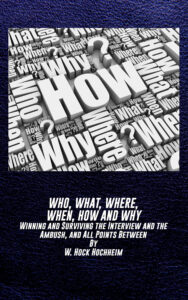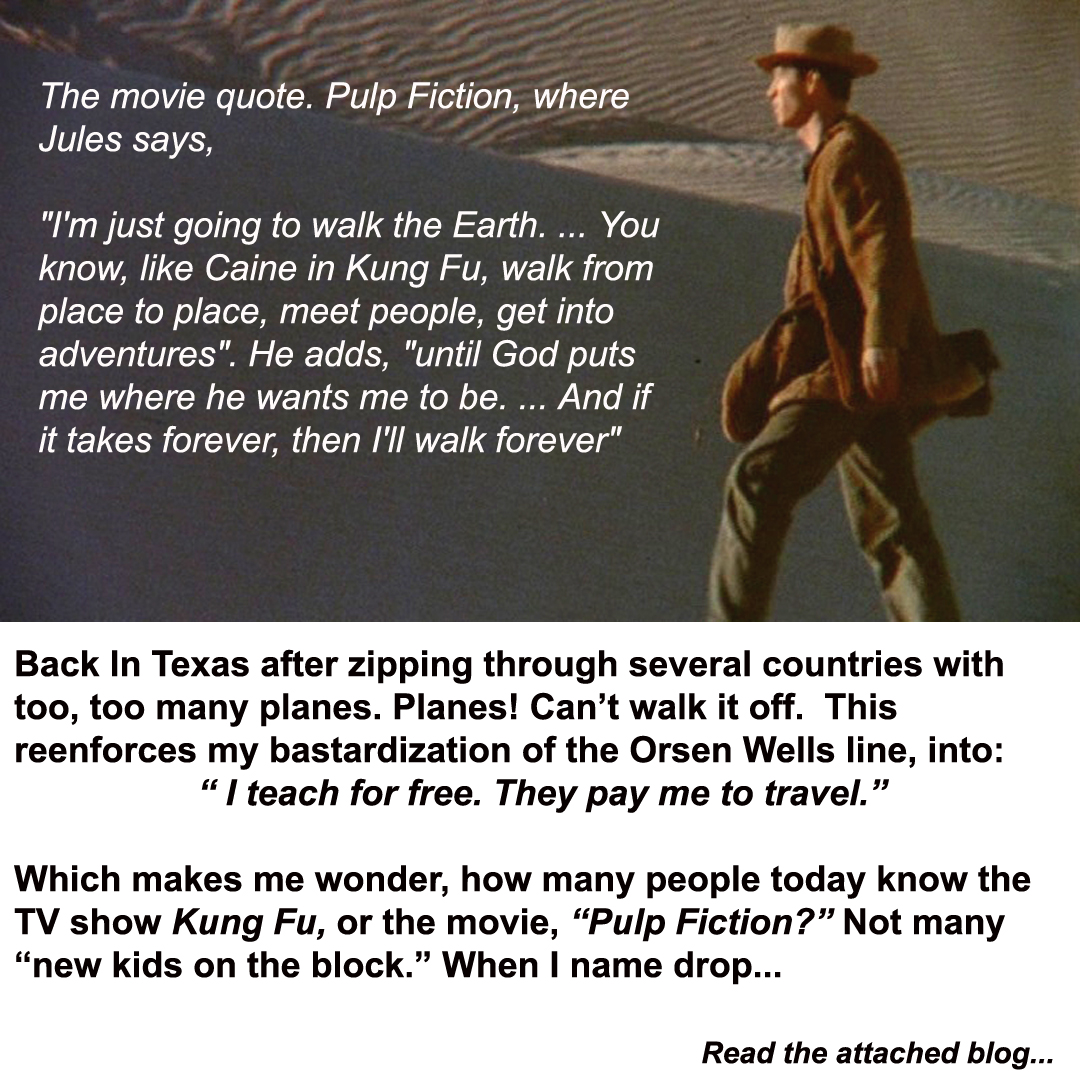I’m just back In Texas again after after zipping through several countries in Europe with too, too many planes. Planes! Can’t walk it off. This reenforces my bastardization of an Orson Wells line, into:
“ I teach for free. They pay me to travel.”
Which makes me wonder, how many people today know orson Wells, the TV show Kung Fu, or the movie, “Pulp Fiction?” Not many “new kids on the block.” The movie quote from Pulp Fiction, Jules says, “I’m just going to walk the Earth. … You know, like Caine in Kung Fu, walk from place to place, meet people, get into adventures”. He adds, “until God puts me where he wants me to be. … And if it takes forever, then I’ll walk forever”
So, I do wonder, how many people today know the TV show Kung Fu, or the movie, “Pulp Fiction?” Not many “new kids on the block.”
My 30th year of traveling and teaching encompasses about 16 countries. 170 some-odd USA cities and about 70 cities outside the USA. Topic? Generic hand, stick, knife, gun and generic FMA, without “borders,” all in the worlds of systemic arts “with borders.” Leading me to the business advice, “Do and make what the others have not done or made.” On occasion, when I glance at my 1990s and 2000s travel schedule I just gasp! Nowadays I need at least two weeks of rest between seminars. The paranoid Covid years gave me a LOT more time off. Still though, currently I am on a 6-week run.
Caine? Kung Fu? In these 30 years have seen the past forgotten, like Caine in Kung Fu and Pulp Fiction and the Lone Ranger and Sean Connery and Roger Moore were once James Bondand, and and…
A.I. said: “That line from Pulp Fiction is Quentin Tarantino’s nod to the 1970s TV series Kung Fu (starring David Carradine as Kwai Chang Caine).
In the show itself, Caine never says those exact words—there’s no line like “I’m just going to walk the Earth” or the full sentiment Jules expresses. But the idea absolutely comes from Kung Fu’s central premise:
- Caine is a Shaolin monk exiled from China after killing the Emperor’s nephew in defense of his master.
- He wanders the American Old West, traveling on foot from town to town, helping people, righting wrongs, and seeking his half-brother.
- The show frequently uses narration and flashbacks to his Shaolin training, with his masters reminding him to follow the Tao, avoid violence, and live in harmony with the world.
So, while the line is Tarantino’s invention, the spirit of it, “walk the Earth, ”is directly lifted from Kung Fu’s descriptions. Caine does say similar things like:
“I seek only to walk in peace.”
“I am a man who has no home.”
“Where I go, I do not know.”
Those kinds of lines clearly inspired Jules’s phrasing.
What of past traveling martial arts instructors? Many like to hunt down the past to have bragging rights that THEIR martial art is the motherlode original. Artificial Intelligence sticks with this version…
I. Ancient and Pre-Modern “Traveling Instructors” 1. Buddhist Monks and the Shaolin Tradition (c. 500–1500 CE)
- Bodhidharma (Damo) — semi-legendary Indian monk credited with traveling to China around the 6th century to teach Chan (Zen) Buddhism at the Shaolin Temple.
- Though stories of him teaching martial exercises (Yi Jin Jing, muscle-tendon training) are later embellishments, he symbolizes the itinerant teacher combining physical and spiritual discipline.
- Shaolin monks regularly traveled across China for religious missions and protection work, spreading temple boxing (quanfa).
- By the Tang and Song dynasties, Shaolin methods had spread throughout the empire, influencing many civilian and military arts.
(Why they matter: They were the earliest known martial missionaries, transmitting skills while traveling, though framed as monastic service rather than paid instruction.)
2. The Ronin and the Wandering Samurai (c. 1500–1800 CE)
- During Japan’s Sengoku and Edo periods, ronin (masterless samurai) roamed the countryside offering their swordsmanship for hire or challenge.
- Many famous swordsmen—Miyamoto Musashi (1584–1645) chief among them—traveled extensively, dueling, teaching, and establishing ryu (schools).
- Musashi’s Book of Five Rings came from this experience.
- These men were traveling instructors before there were dojos—teaching one-on-one, founding local schools after proving themselves.
(Why they matter: They represent the prototype of the traveling, teaching martial artist—personal, challenge-based instruction centuries before Kano’s organized system.)
3. Chinese Opera Troupes and Martial Performers (Ming–Qing dynasties)
- Itinerant acrobatic troupes, many with military or Shaolin backgrounds, traveled from town to town performing martial dances, weapon routines, and lion dances.
- They often doubled as teachers for locals who wanted self-defense or fitness.
- These performers helped diffuse southern Chinese arts like Hung Gar, Choy Li Fut, and Wing Chun across regions.
(Why they matter: They made martial arts popular entertainment and taught on the road — the first blend of commercial showmanship and instruction.)
II. Early-Modern and Modern Teachers (1800–1945)
4. The Jiujitsu Envoys (1870s–1910s)
- After Japan’s Meiji Restoration, the new government promoted cultural exports.
- Martial artists like Katsukuma Higashi, Yukio Tani, and Sadakazu Uyenishi traveled to Europe demonstrating jujutsu — often as showmen or “challenge wrestlers.”
- They opened small schools in London, Paris, and New York decades before Judo became organized worldwide.
(Why they matter: The first Japanese to teach martial arts commercially outside Japan.)
5. Jigoro Kano (1860–1938) – The Systematizer
- Founded Kodokan Judo (1882) by refining old jujutsu systems into a coherent educational model.
- He trained and dispatched instructors abroad — e.g., Yoshiaki Yamashita to the U.S. (1902), Gunji Koizumi to the U.K. (1918).
- Kano traveled widely as an educator and diplomat, advocating Judo as physical and moral education.
(Why he matters: He created the first modern, globalized martial arts education system, with ranks, curriculums, and standardized teaching — not just individual wanderers.)
6. Gichin Funakoshi (1868–1957) – The Cultural Ambassador
- An Okinawan schoolteacher who demonstrated Karate in Tokyo (1922) at Jigoro Kano’s invitation.
- Stayed in Japan, spreading Karate through the university system.
- His journey from Okinawa to the mainland is often called the first modern “teaching mission” for Karate.
7. Morihei Ueshiba (1883–1969) – The Spiritual Traveler
- Traveled throughout Japan teaching Aikido, combining jujutsu, swordsmanship, and spiritualism.
- Sent students overseas post-WWII; his art became an international phenomenon only after 1950.
III. Post-WWII “Traveling Teachers” Who Globalized the Arts
- Mas Oyama (Kyokushin Karate) — taught around the world, 1950s–70s.
- Bruce Lee (Jeet Kune Do) — cross-cultural fusion and demonstration tours, 1960s–70s.
- Dan Inosanto, Remy Presas, Ed Parker, et al. — 20th-century examples of modern itinerant instructors, echoing Musashi’s and Kano’s legacy but on a global commercial stage.
Summary: They have traveled the Earth. Some of us, from circumstance and luck, fate, whatever, still “walk” the Earth and teach martial material, and in my case interspersed with a little who, what, where, when, how and why advice on life, love and fighting…

